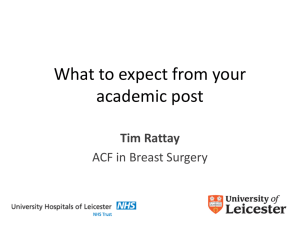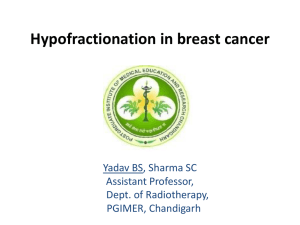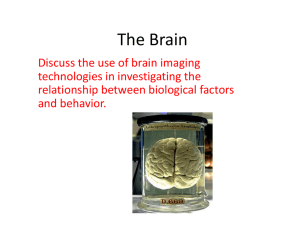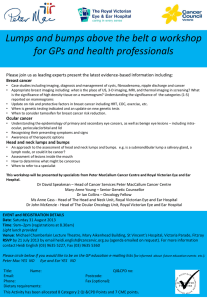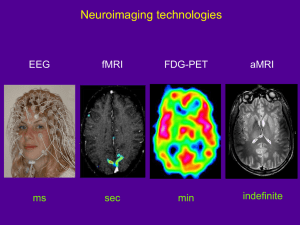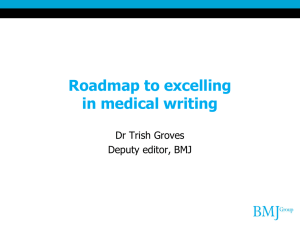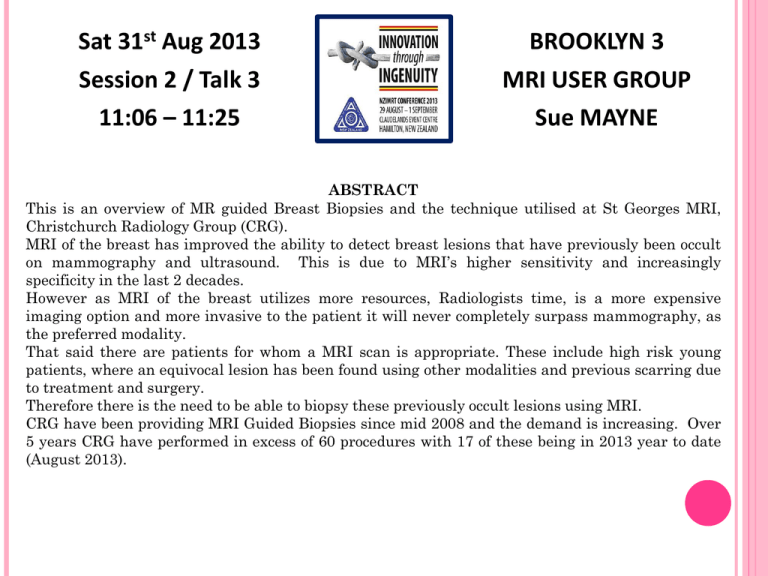
Sat 31st Aug 2013
Session 2 / Talk 3
11:06 – 11:25
BROOKLYN 3
MRI USER GROUP
Sue MAYNE
ABSTRACT
This is an overview of MR guided Breast Biopsies and the technique utilised at St Georges MRI,
Christchurch Radiology Group (CRG).
MRI of the breast has improved the ability to detect breast lesions that have previously been occult
on mammography and ultrasound. This is due to MRI’s higher sensitivity and increasingly
specificity in the last 2 decades.
However as MRI of the breast utilizes more resources, Radiologists time, is a more expensive
imaging option and more invasive to the patient it will never completely surpass mammography, as
the preferred modality.
That said there are patients for whom a MRI scan is appropriate. These include high risk young
patients, where an equivocal lesion has been found using other modalities and previous scarring due
to treatment and surgery.
Therefore there is the need to be able to biopsy these previously occult lesions using MRI.
CRG have been providing MRI Guided Biopsies since mid 2008 and the demand is increasing. Over
5 years CRG have performed in excess of 60 procedures with 17 of these being in 2013 year to date
(August 2013).
Breast Biopsy under MRI
Guidance at St Georges
Radiology
Sue Mayne
MRI of the Breast
MRI
has become increasingly utilized diagnostic
tool for imaging of the breast and in certain
instances invaluable.
Mammography will always be the tool of choice
for breast screening.
Due to MRI’s increasing ability to demonstrate
occult lesions, there has become the need for MRI
Guided Biopsies.
Indications for MRI of the Breast
Screening
of high risk women, eg BRACA.
Pre operative screening.
Equivocal lesion on other modality.
Previous scarring due to treatment.
Positive axillary node found but no breast cancer
evident.
Monitoring or prior to treatment –chemo or
radiotherapy.
Breast implants ? Leakage ?Cancer
Advantages of Breast MRI
Better
sensitivity than mammography.
Increased specificity.
Minimal compression required.
Excellent soft tissue contrast.
Non ionising Radiation.
Performance unaffected by breast density.
Multiplanar acquisition.
Disadvantages of Breast MRI
Cost.
Availability.
Time
involved,
Client
30 min appointment vs. 15 min mammo
Radiologist 100’s images vs. 4-8 mammographs
Some
low grade DCIS maybe occult on MRI but
visible micro calcifications on mammograms.
Requires an IV injection of gadolinium.
MR contra indications eg pacemaker or severe
claustrophobia.
MRI Breast biopsy’s
Biopsy
of the breast faces many challenges
the biggest problem is if a lesion can not be
demonstrated on mammography or
ultrasound.
Breast biopsies under MRI guidance can
resolve this challenge.
Sometimes the lesion can be found on a
second look U/S and biopsied in this way.
Challengers with MRI Guided Biopsy
Compatible
equipment.
Patient Safety.
Artefact due to metal needles.
No real time imaging while positioning.
Indications for MRI Breast Biopsy
The
lesion is not able to be demonstrated on
either mammography or ultrasound.
All
our Breast biopsies are
performed at St Georges Radiology.
Although
the majority of the Breast
MRI’s done with CRG are at Hagley
3.0T, the biopsy’s are done at St
Georges.
St Georges has a 1.5T which all the
equipment is compatible with.
St Georges has the availability of
Day Surgery onsite if the patient is
having a hookwire and proceeding to
theatre.
Breastcare is on the same site also,
if a post biopsy mammogram is
required.
GE
1.5 T Signa System
A GE Array 4 channel dedicated
breast coil
The Invivo breast immobilization
and biopsy device
Since 2010 we have used The ATEC
Suros Vacuum Assisted Biopsy (VAB)
Hand Piece and Console.
Titanium Biopsy Site MarkerCliplock by ATEC.
Equipment
Only
the localization of the lesion and the
verification of the position of needle are performed
under MR guidance.
Appointment
is organized in
conjunction with Specialised
Radiologist and MRI Technologist
availability.
Review the previous MRI with the
Radiologist - Position
- Sequences
Prior to
Biopsy
Patient
arrives 30 min prior to
appointment.
Patient is already familiar with MRI,
contrast and safety considerations.
Re check Safety.
Procedure consented by radiologist.
Sedation is discussed.
Patient changed into front opening
gown.
IV access obtained.
Prior
Biopsy
to
This
is dependent on the lesion and
the size of the breast.
Patient
Position
Lateral
Approach
Patient
is positioned prone with
breast of interest positioned in the
breast coil.
The other breast is positioned out of
the way by placing a pad over the
breast coil.
Patient
Position
The
arms are positioned above the
head
Medial light compression is applied
The breast needs to immobilized for
the biopsy
Patient
Position
Medial compression
paddle
Localisation Grid
Compression
It
is important to immobilize the
breast and push the breast up
against the localization grid.
Compression
This will aid in the visualization of the grid –
the grid itself is not imaged but rather the
indentations created by the grid.
Only will good compression permit accurate
needle positioning and therefore a successful
biopsy or hookwire position be ach achieved.
BUT moderate compression is recommended so
contrast enhancement is not compromised.
Medial
Approach
We
do not have medial access with our
Breast coil.
The breast is positioned in the opposite
breast coil with the unaffected side tilted
slightly up.
This will vary patient to patient due to
patient physique.
Patient
Position
3
plane Localizer
Calibration
To
scan
allow for parallel imaging using ASSET
Axial
T1
Axial
Vibrant Pre Contrast
A
T1 fat sat image specifically designed for
breast imaging
Fast 3D gradient sequence with high
spatial and temporal resolution
Axial
Vibrant Post Contrast
Sequences
The
sterilized grid is positioned
against the disinfected breast and an
oil capsule is put in the grid in
approximate position,
Scan
Localizer
Calibration
Scan
Axial
T1
Axial Vibrant Pre Contrast Scan.
The
oil capsule maybe adjusted at
this time before contrast is given if
necessary.
Procedure
The
previous 3.0T MR can be used to
identify the target lesion and
therefore Gd may not be required.
The increased resolution and signal
of 3 T is obvious when comparing with
the 1.5 T
Contrast is usually given but we
often start with 5mls as opposed to
10mls of Gad
Procedure
In
the IVI screen the lesion can be
located in all planes.
The cursor can now be used to
accurately locate the lesion.
Procedure
Once
the area is localized and the
depth worked out the patient is
brought out of the magnet.
Sterile propacks and other
equipment are opened.
The radiologist will inject local
anaesthesia.
A small incision is made using a
plastic handled scalpel.
The block is positioned in
appropriate grid space.
Procedure
Introducer Localization System
Introducer Sheath
Obturator
Introducer
Stylet
Block
Depth
guide is adjusted on the
sheath and the stylet is then placed in
this sheath.
The stylet and introducer are
inserted in the breast via the
appropriate grid hole.
Procedure
Stylet
is removed and obturator (has low metal
artefact) placed in introducer.
The most appropriate sequence is preformed to
check placement.
Adjustments may need to be done and rechecked.
The
biopsy gun kit is opened and set
up.
Procedure
The
SUROS is tested and then the
hand piece and foot peddle are
brought into the MRI room.
The console remains outside the
room at all time.
Procedure
The
Radiologist positions the
needle at the required depth in the
introducer and the biopsy is
performed.
The Radiologist will perform 6 - 10
samples in the one pass.
Procedure
When
the biopsy gun is discharged
the patient should not feel pain but
will feel pushing.
It is wise to warn the patient of the
sound of the biopsy gun as it is
imperative the patient is still at this
important part of the procedure.
Procedure
Once
the biopsy is complete a clip
lock maybe inserted.
This is detectable on Mammography,
Ultrasound and MRI.
Half the size of a staple.
Helps to identify region for future
procedures and treatment.
Procedure
Steristrips
and opsite dressing are
applied.
10-20 mins compression and icepack
is applied to reduce swelling.
Aftercare Form is given to the
patient.
If cliplock has been inserted a
Mammogram is performed to confirm
position.
Aftercare
What size and shape works best?
The
most difficult breast shape to work with is
small dense breasts.
Tips for small breasts
Remove
the pad on the coil.
Displace the patient to the side of interest
to bring them closer to the grid.
Rolling the patient opposite side up will
bring in more lateral tissue.
Rolling the Patient affected side up can
bring in more medal tissue.
Padding the medial compression plate .
Work load
2008
(6 months) 5 Cases
2009
5 cases
2010
9 cases – Suros intro July
2011
11 cases
2012
13 cases
2013 (7 mth)
17 cases to date August.
What have we changed
The
use of Suros (VAB) has definitely speed
up the procedure.
Although patients are still consented for
sedation unless the patient is very anxious or
the procedure goes a lot longer than normal it
is not usual to give it.
Acknowledgements
Thanks to Dr Jerry Sharr, Claire Overend, and my
wonderful anonymous models.
REFERENCES
Philpotts, L E. (2010). Magnetic Resonance Imaging Clinics of North America, Breast MRI vol
18(323-332). MR Intervention : Indications, Technique, Correlation and Histologic.
Meeuwis C, Veltman J, Hester N et al. (2012). Euro Radiology 22:341-349. MR-guided breast
biopsy at 3T: diagnostic yield of large core needle biopsy compared with vacuum-assisted biopsy.
Mann R. M, Kuhul C K, et al. Euro Radiol (2008) 18:1307-1318. Breast MRI: Guidelines from the
European Society of Breast Imaging.
Boo-Kyung H, Mitchell D S, et al. (2008) AJR, vol 191, number 6, 1798-1804.Outcome of MRIGuided Breast Biopsy.


